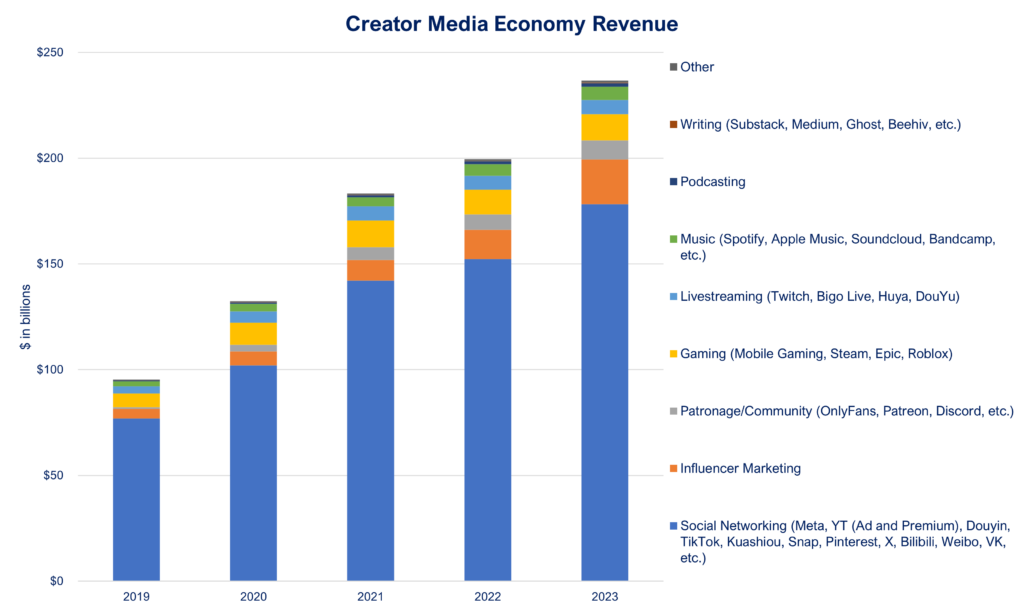Content
Stay up to date on the latest happenings in digital marketing
There’s a reason influencer marketing has tripled since 2019. There’s also a reason why it’s forecast to continue to grow at a steaming hot 32% compound annual growth rate between 2025 and 2030. Neither of those numbers are an accident, and there are multiple ecosystem-level drivers propelling the continued growth of influencer marketing as well as — by natural extension — UGC ads. And all of it is substantially changing the advertising landscape.
The primary driver is the rise of the creator economy.
In fact, Evan Shapiro, the “unofficial cartographer” of the media ecosystem, says that 2025 is the year of the creator:
“My most specific prediction for 2025 is that November of 2024 will be remembered as the moment that Creator Media surpassed Corporate Media in global relevance.”
– Evan Shapiro
(November of 2024 was, of course, the U.S. election, where chats with Joe Rogan appeared to be more powerful in swaying votes than visits to top broadcast TV news shows.)
While corporate media has grown at about 5% annually over the past few years, creator media has grown at over 25% annually, powered by none other than user-generated content. Or, if you will, creator-generated content.
The result is that the creator media economy has grown to a $250 billion dollar behemoth as of 2023.
Note: For this blog post, I’m indebted to both Evan Shapiro, who runs the Media War & Peace substack, and Doug Shapiro (no relation, AFAIK) who runs The Mediator.
Corporate vs creator media economies
The corporate media ecosystem is the one we’re most familiar with. While it has its traditional players like NBC and the NYT, it also has its disruptors in Netflix and Prime Video. In the gaming world it includes most of the major players we’re familiar with in both the console/PC and the mobile spaces: EA, Activision, Ubisoft, Epic, Take-Two, Supercell, Rovio, Zynga, Tencent, and so on.
The core identifier of the corporate media economy is that it takes control of most of the steps between creation of something good, interesting, fun, and valuable (please don’t call it content) and the consumption, use, or enjoyment of that thing.
Those steps, of course, include:
- Ideation
- Production
- Marketing
- Distribution
- Monetization
- Consumption
In step 1, a creator, artist, producer, or coder writes or invents or programs. You and I and all of us collectively handle step 6. The corporate media ecosystem manages everything else sandwiched in the middle.
In some ways the creator media economy is much simpler.
Creators … create, but they also take on responsibility for production, some responsibility for marketing, and some responsibility for monetization. They’re aided by what Shapiro calls enabling platforms, and we all know their names:
- YouTube
- Spotify
- Patreon
- Steam
- And others, of course
Enabling platforms distribute, sure, but they also help with production in some cases. Think of Spotify’s acquisition of Anchor, which became Spotify for Creators, providing tools to “create, distribute, host, and monetize your podcast, 100% free.” They also market, in a sense: if your video, image, newsletter, or game tickles the fancy of an enabling platform’s algorithms, they’ll ship it to more and more eyeballs and feature it more prominently in the feed.
The result is a collapse of the traditional corporate media model with its traditional intermediaries and steps down to the modern media model:
- Anyone creates
- Platforms package/distribute/monetize
- People read/watch/play … and in some cases pay
And this is across the board in media of almost all kinds. As the former chief strategy officer of Turner (WarnerMedia) Doug Shapiro highlights, it’s everywhere:
- Social networking
Meta, YouTube, Douyin, TikTok, Snap, Pinterest, X, Weibo, VK - Patronage/community
OnlyFans, Patreon, Discord - Gaming
Mobile gaming, Steam, Epic, Roblox - Livestreaming
Twitch, Bigo Live, Huya, DouYu - Music
Spotify, Apple Music, Soundcloud, Bandcamp - Podcasting
YouTube, Spotify, Apple - Influencer marketing
Aspire, GRIN, CreatorIQ, Upfluence, BuzzSumo - Writing
Substack, Medium, Ghost, Beehiiv
Influencer marketing is a big beneficiary
I’ve been watching YouTube on the big screen more and more lately.
What no-one tells you when you buy a big-ass 4K TV is that all the non-4K content on your legacy cable, satellite, or fiber provider looks SO MUCH CRAPPIER than on your old not-so-big 1080P TV. (Yeah, on-the-fly digital upscaling is much more marketing than reality.)
But YouTube has a lot of 4K content, and views are reportedly doubling annually.
So I’m watching more YouTube. It just looks SO GOOD.
But there’s increasingly a jarring disconnect between the content I’m watching and the shiny happy traditional boob tube commercials with polished jingles and professional soundtracks that brands are pulling from broadcast TV and shoehorning into YouTube pre-rolls.
They just don’t really … fit.
What works during the Super Bowl doesn’t necessarily work when watching a dude build an off-grid cabin with 1800’s-era tools. Or a bunch of podcasters vibing about the newest new thing.
And that’s likely to increasingly be the scenario as the creator media economy overtakes the corporate media economy. Which means that influencer content and influencer advertising, often in UGC form, is not only going to fit the increasingly-dominant new form of media. It also means that — as we’ve already seen — existing corporate ads are more and more taking on the flavor of influencer and UGC ads.
Influencer marketing agencies are exploding
Publicis bet $500 million on the creator economy by buying influencer marketing agency Influential in July of 2024.
We’re likely to see many more such mergers and acquisitions.
A decade ago in 2015, there were only 190 influencer marketing agencies and platforms globally, By 2021, that number exploded to 18,900. That’s up a massive 75% compared to 2019. There’s little chance so many players will succeed, but many will be acquired, acqui-hired, or merged to build larger and more comprehensive solution sets for advertisers.
(Look at any “top influencer marketing agencies” list: almost all are under 200 employees. Most are under 50 … not exactly a hobby or lifestyle business, but not far removed.)
The creator economy end game
There’s no obvious end in sight to the key driver of the creator economy: the unlocking of global creativity in hundreds of millions if not billions of people.
Doug Shapiro estimates that the creator economy was worth almost $250 billion in 2023. That includes all the revenue from advertising, subscriptions, and transactions, but not direct sponsorships, which he did not (could not, because it’s not public information) include in his calculations.
Notice that the bulk is via Meta, YouTube, Doyin, TikTok, Snap, and Pinterest, etc.).

That is guaranteed to have grown in 2024, and based on the trajectory we see now, will continue to grow in 2025.
Importantly, that’s a zero-sum game.
At some point, people can’t consume more content, watch more video, read more, or listen to more podcasts. So revenue added to the creator economy is essentially revenue subtracted from the corporate economy … which is why you see slow nominal growth of 5% annually in the corporate media economy (but actual decline when you take inflation into account) compared to 25% annual growth for the creator media economy.
The reason is that creators have been unleashed:
- Hollywood makes 15,000 hours of TV and film annually, but creators upload 250 million hours of video to YouTube alone every year
- 225,000 professional musicians upload about 5 million tracks to Spotify annually, but 10 million others upload 37 million
- Xbox has 3,000 games, but there are 100,000 games on Steam, maybe a million on the iOS and Android app stores
- We took 80 billion photos in 2000, but 2 trillion in 2024
Unleashed indeed!
Oh, and generative AI is likely to be a multiplier on both the quantity and quality of creator economy media that gets published. A massive multiplier. At some point, fully genAI stuff created at the instigation of AI without even the intermediation of a creator is likely to become big.
(We already see it in music and have for some time.)
As Doug Shapiro says:
“People create more when creation is more accessible.”
GenAI or no genAI, most of what creators publish is crap, sure. But the best is really, really good, increasingly challenging the best of what the corporate model can create. The end game doesn’t have to be that the creator economy overtakes or consumes the corporate media economy, though it could become more than half of its value.
But the end game is that the creator economy becomes as important if not more important than the corporate media economy.
And that changes … a lot.
More on that in the future.
More on influencer marketing
Interested in more on this phenomenon? Check out these additional recent resources:
- How to scale influencer marketing: 10 key tips
- 8 key influencer marketing tips
- Hack gaming growth (especially episode 3 on channel diversification)
- Creative formats that win (particularly the UGC parts)
- Retail subscriptions & going viral on Tiktok Shop with GNC VP Vivian Chang
- User acquisition diversification: DOOH, CTV, podcasts, radio



